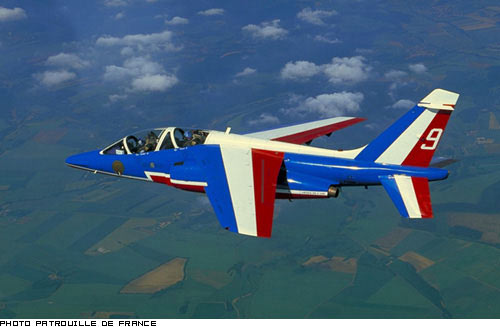Dassault-Bréguet/Dornier Alphajet
Summary
| Category | Combat aircraft |
| Origin country | 🇩🇪 Germany 🇫🇷 France |
| First flight | 26 October 1973 |
| Year of introduction | 1978 |
| Number produced | 480 units |
| Average unit price | $8 million |
Description
In the early 1960s, several European air forces recognized a need for a new generation of jet trainers to replace aircraft like the Lockheed T-33 and Fouga Magister. Initial collaboration between Britain and France to produce a supersonic jet for both training and light attack roles led to the SEPECAT Jaguar, which evolved into a nuclear-capable strike fighter, not suited for basic training. Consequently, France initiated discussions with West Germany in 1967 for a collaborative effort. By 1968, a joint specification for a subsonic trainer aircraft was produced, and in July 1969, a joint development and production agreement was signed, committing both nations to purchase 200 aircraft, to be assembled domestically. Competing proposals from Dassault, Breguet, and Dornier ("TA501"), VFW-Fokker ("VFT-291"), and SNIAS/MBB ("E.650 Eurotrainer") were evaluated, with the TA501 declared the winner on July 23, 1970. Dassault was designated the lead company, and construction of four prototypes commenced, two by Dassault in France, and two by Dornier in Germany. The first French prototype flew in October 1973, followed by the first German prototype in January 1974.
The Alpha Jet is a light twin-engine jet, whose simple airframe belies its high performance. Its design, developed with the assistance of CAD, adheres to the area rule, while both the leading edges and air intakes are fixed. The aircraft makes use of fully powered controls incorporating dual-hydraulic systems, with a load-factor limited dynamic feel system arrangement linked to conventional flight control surfaces. For enhanced crew comfort during training flights, the cockpit is pressurized. Attention was given to rapid turnaround times, aiming for just ten minutes with minimal ground equipment, achieved through features like single-point pressure refueling, ladder-less cockpit access, and a liquid oxygen system capable of ten hours of endurance. The Alpha Jet is equipped with five hardpoints, four on the wings and one at the centerline on the lower fuselage, capable of carrying nearly 5,000 lb of munitions and equipment.
When configured for armed missions, a gun pod containing either a 30 mm DEFA cannon (as installed on French aircraft) or a 27 mm Mauser BK-27 cannon (as installed on German aircraft) is typically mounted on the centerline hard point. For air-to-air defense, it can carry two AIM-9 Sidewinder or Matra Magic II missiles. Furthermore, the Alpha Jet can be equipped with two Matra rocket pods, each housing eighteen SNEB 68 mm rockets, or two CRV7 rocket pods, each with nineteen 70 mm rockets. For ground attack, it is cleared to carry a variety of bombs, including cluster bombs like the Hunting BL755. The aircraft also has provisions for carrying two 310 L drop tanks to extend its range.
The French Air Force adopted the Alpha Jet primarily as a trainer, with the first production aircraft for French service flying in November 1977 and entering line service in May 1979 as the Alpha Jet E. It replaced the Canadair T-33 and Fouga Magister in jet training roles and the Dassault Mystère IVA in weapons training. In contrast, the Luftwaffe primarily used the Alpha Jet in the light strike role, replacing the Fiat G91R/3 fleet, and also employed it in electronic countermeasures and aerial reconnaissance roles, with a reconnaissance pod for the latter. During the 1991 Gulf War, 18 German Alpha Jets were deployed to Turkey as part of a NATO operation. The Nigerian Air Force deployed four Alpha Jets in 1990 to support ECOMOG forces in Liberia, significantly enhancing their firepower and later employing them extensively against the NPLF. The Royal Moroccan Air Force used its Alpha Jets in strike missions against the Polisario Front during the Western Sahara War, losing one aircraft in December 1985.
Main Variants:
-
Alpha Jet A: The attack version, originally used by Germany, was optimized for close air support and tactical strike missions.
-
Alpha Jet E: The trainer version, initially operated by France and Belgium, was designed for advanced pilot training.
-
Alpha Jet 2: This was a development of the Alpha Jet E that was further optimized for ground attack, featuring improved avionics.
-
Alpha Jet MS1: This close support-capable version was assembled in Egypt, serving in both training and light attack roles.
-
Alpha Jet MS2: An improved Egyptian version with new avionics, an uprated engine, compatibility with Magic Air-to-Air missiles, and a Lancier glass cockpit.
Technical specifications
| Version: Dassault-Dornier Alpha Jet A | |
|---|---|
| Crew | 2 pilots |
| Operational range | 2600 km (1616 mi) |
| Maximum speed | 1000 km/h (621 mph) |
| Wing area | 17.5 m² (188.4 sqft) |
| Wingspan | 9.1 m (29.9 ft) |
| Height | 4.2 m (13.7 ft) |
| Length | 13.2 m (43.4 ft) |
| Service ceiling | 14630 m (47999 ft) |
| Empty weight | 3515 kg (7749 lbs) |
| Max. takeoff weight | 7500 kg (16535 lbs) |
| Climb rate | 57.0 m/s (187.0 ft/s) |
| Powerplant | 2 × turbojets SNECMA-Turbomeca Larzac 04-C5 delivering 1350 kgp |
| Ejection seat | UPC Stencel S-III-S3IA63 |
Current operating countries
| Country | Units | ||
|---|---|---|---|

|
Egypt | 40 | |

|
France | 29 | |

|
Morocco | 22 | |

|
Thailand | 18 | |

|
Nigeria | 12 | |

|
Bulgaria | 6 | |

|
Qatar | 6 | |

|
Togo | 5 | |
Numbers in parentheses, e.g. '(+5)', indicate units ordered but not yet delivered.
All operators
Armament

